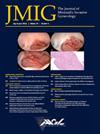Bowel Endometriosis Excision: Approaches and Outcomes Including Hand Sewing of Discoid Excision
IF 3.5
2区 医学
Q1 OBSTETRICS & GYNECOLOGY
引用次数: 0
Abstract
Study Objective
To examine the outcomes of surgery performed for bowel endometriosis including shaving, discoid resections with hand-sewn closure, and segmental resection.
Design
Retrospective cohort study.
Setting
Large academic hospital.
Patients
All patients with bowel wall endometriosis who underwent surgical excision with the Division of Minimally Invasive Gynecologic Surgery between 2009 and 2022.
Interventions
No interventions administered.
Measurements and Main Results
From 2009 to 2022, a total of 112 patients underwent laparoscopic excision of endometriosis involving the rectum. From this cohort, 82 underwent shaving, 23 underwent discoid excision, and 7 had segmental bowel resection. The discoid excisions were closed in multiple layers with hand sewing and were not closed with a staple device. Average lesion size on preoperative imaging was 20.9 mm in the shave group, 22.5 mm in the discoid group, and 38.5 mm in the segmental group. Complication requiring reoperation for anastomotic leak occurred in 3 cases (3.66%) of the shave group and 1 case (4.35%) of the discoid excision group, but did not occur in any of the segmental resections. The number of layers of closure and type of suture used did not appear to have an effect on complication rate, however, this study was not powered to detect a meaningful difference.
Conclusion
Our data shows a similar rate of anastomotic leak complication for each closure type as that reported in the literature (2.2%, 9.7%, and 9.9% reported for shave, discoid and segmental resection, respectively). While our study is underpowered, these findings support that hand sewing for discoid excision is a safe and reasonable alternative to circular stapler closures and can be considered with an experienced surgeon. Further study is warranted to confirm safety and explore potential cost savings associated with this technique as well as applications in areas with less resources available.
肠道子宫内膜异位症切除术:包括盘状切除的手工缝合在内的方法和结果。
研究目的研究肠道子宫内膜异位症手术的效果,包括刮除、盘状切除加手缝合和节段切除:设计:回顾性队列研究:大型学术医院 患者: 所有肠壁子宫内膜异位症患者2009年至2022年期间在妇科微创外科(MIGS)接受手术切除的所有肠壁子宫内膜异位症患者:未采取干预措施:2009年至2022年期间,共有112名患者接受了腹腔镜直肠子宫内膜异位症切除术。在这批患者中,82 人接受了刮除术,23 人接受了盘状切除术,7 人接受了肠段切除术。盘状切除术采用多层手工缝合,不使用订书机。术前造影显示,剃除组的平均病灶大小为20.9毫米,盘状切除组为22.5毫米,节段切除组为38.5毫米。3例(3.66%)剃除组和1例(4.35%)盘状切除组患者因吻合口漏而需要再次手术,但没有任何节段切除患者出现这种并发症。闭合层数和缝合线类型似乎对并发症发生率没有影响,但本研究并不具备检测有意义差异的能力:我们的数据显示,每种闭合类型的吻合口漏并发症发生率与文献报道的相似(刮除术、盘状切除术和节段切除术的并发症发生率分别为 2.2%、9.7% 和 9.9%)。虽然我们的研究动力不足,但这些研究结果支持盘状切除术的手工缝合是环形订书机闭合的一种安全、合理的替代方法,有经验的外科医生可以考虑采用这种方法。有必要进行进一步研究,以确认该技术的安全性,探索其潜在的成本节约以及在资源匮乏地区的应用。
本文章由计算机程序翻译,如有差异,请以英文原文为准。
求助全文
约1分钟内获得全文
求助全文
来源期刊
CiteScore
5.00
自引率
7.30%
发文量
272
审稿时长
37 days
期刊介绍:
The Journal of Minimally Invasive Gynecology, formerly titled The Journal of the American Association of Gynecologic Laparoscopists, is an international clinical forum for the exchange and dissemination of ideas, findings and techniques relevant to gynecologic endoscopy and other minimally invasive procedures. The Journal, which presents research, clinical opinions and case reports from the brightest minds in gynecologic surgery, is an authoritative source informing practicing physicians of the latest, cutting-edge developments occurring in this emerging field.

 求助内容:
求助内容: 应助结果提醒方式:
应助结果提醒方式:


